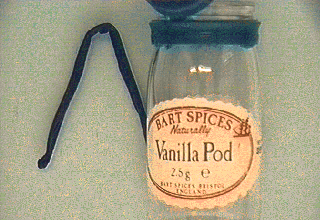 Vanilla pod.
Vanilla pod.
 Vanilla pod.
Vanilla pod.
Following the discovery of a technique for artificial pollination (about 1841) plantings were setup in Jamaica and other islands in the West Indies.
Vanillin, the crystalline component, was first isolated from vanilla pods by Gobley in 1858. By 1874 it had been obtained from glycosides of pine tree sap, temporarily causing an economic depression in the natural vanilla industry.
The plant (Vanilla planifolia) is a tropical orchid
which grows as a vine and needs the support of trees or poles
whereupon it can reach a height of about 5 metres. The flowers
have a narrow bell surrounded by thin petals which develop slowly
over several months into long narow pods about 12-15 cm long.
Vanilla needs a process of curing similar to cacao to develop its
characteristic aroma, for example the pods may be picked green
then sun dried, oven heated or cured in hot water.
During the curing process the flavour precursors, which are
glucosides, are broken down into vanillin and glucose and some
other minor aromatic substances.
Vanilla extract is made by cutting the beans into small pieces
and soaking in successive quantities of hot 65-70% alcohol. Many
commercial vanilla extracts are now actually blends from natural
and synthetic vanillin.
The "classical" synthesis of
vanillin
from
eugenol
or
iso-eugenol
was developed in 1896 and it remained the preferred method for about 50
years.
The scheme below is a sensitive map with links to the
individual molecular graphics (MOL) files.
Not all commercial vanillin is industrial?
A Mass Spectrum of vanillin in JCAMP-DX format is available.
It has recently been shown that the 13C/12C ratio can be used to determine the origin of vanillin. This was done by quantitative measurements of the 13C NMR signals for each of the 8 C atoms. It showed that attempts to fraudulently substitute cheaper synthetic vanillin can be detected even when 13C substituted materials are used. Return to Chemistry, UWI-Mona,
Home Page
Return to Chemistry, UWI-Mona,
Home Page
Copyright © 1995-2013 by Robert John Lancashire, all rights reserved.
Created and maintained by Prof. Robert J. Lancashire,